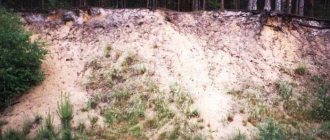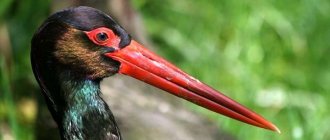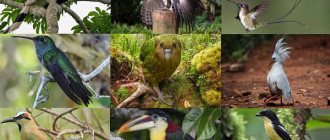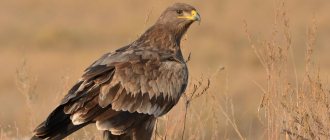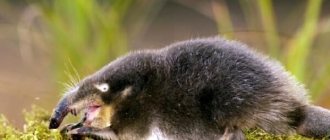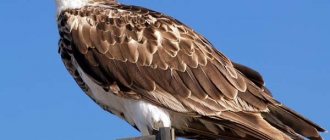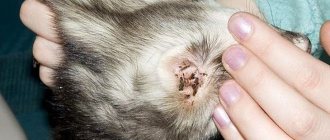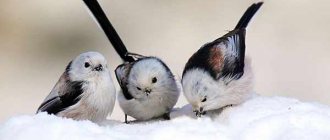longRussian desman (muskrat, crest, lat. Desmana moschata) is a very interesting mammal that lives mainly in the central part of Russia, as well as in Ukraine, Lithuania, Kazakhstan and Belarus. This is an endemic animal (who are endemics), previously found throughout Europe, but now only in the mouths of the Dnieper, Don, Ural and Volga. Over the past 50 years, the number of these cute animals has decreased from 70,000 to 35,000 individuals. Thus, they became famous throughout the world, ending up on the pages of the Red Book as a rare endangered species.
Description of the muskrat
The muskrat is not a very large creature, measuring 18–22 cm, weighing 450–550 g. The body is covered with soft fur, the tail is bare with horny scales, the same length as the body. At the base of the tail there are musk glands that produce an odorous oily substance.
The animal lubricates its fur with musk oil, which prevents it from getting wet and helps mark its area. In the 18th–19th centuries, muskrat musk was used in perfumery as an odor enhancer for perfumes and colognes.
The front legs are short, the hind legs are wide and large. The structure of the paws is characteristic of waterfowl species: there are membranes between the toes, and the edges of the paws are overgrown with stiff bristles. The animal has long, slightly curved claws, which allows it to dig holes and hunt for prey.
Rice. 1. Muskrat.
The nose is in the shape of a proboscis, with nostrils at its end. The eyes are tiny and there is almost no vision. Long vibrissae on the nose, as well as sensitive hairs on the body and between the scales on the tail, help to navigate under water. The muskrat has no ears, but good hearing. The auditory fissure is covered with fur. The nostrils and ear slits are closed by valves under water.
The muskrat's fur has a unique structure - the hairs thicken towards the end, and tiny air bubbles are held between them. Because of this, the animal must actively row underwater, otherwise it will be pushed to the surface like a float.
Rice. 2. Muskrat in water.
Nutrition
Khokhuli are predators that feed on bottom inhabitants. Moving with the help of their hind legs, the animals use their long, movable muzzle to “probe” and “sniff” small mollusks, leeches, larvae, insects, crustaceans and small fish. In winter, they can also eat plant foods.
Despite their small size, muskrats eat relatively a lot. They can absorb up to 500 grams per day. food, that is, an amount equal to its own weight.
Russian muskrat eats a worm
Little muskrats
The nest is located in the main burrow, where 3–5 cubs weighing 2–3 g are born in spring and autumn. The babies are blind, without hair. When leaving to feed, the mother covers them with a layer of plants. If necessary, carries children on their backs to another hole. The father is involved in caring for the children.
The cubs feed on milk for a month and leave their parents after six months.
Rice. 3. Baby muskrats.
In a message for 2nd grade children during a lesson on the world around us, you can briefly describe a muskrat.
Habitat and lifestyle
The Russian muskrat settles on the banks of clean floodplain lakes, ponds and rivers. This is a nocturnal animal. They dig their burrows on land. There is usually only one exit and it leads to a reservoir. The length of the tunnel reaches three meters. In summer they settle separately; in winter, the number of animals in one burrow can reach 10-15 individuals of different sexes and ages.
SNEETER
This bird species in the Moscow region belongs to category 0, that is, it is considered completely extinct. But recently, experts made the assumption that two pairs could nest in the Zhuravlinaya Rodina nature reserve, as well as in several protected areas. Perhaps there are only about five pairs of these birds left in the region. The potential nesting site is protected in five reserves of regional significance in Shatura, Lotoshino, Taldom and Sergiev Posad districts. The last time the snake eagle nested en masse in the Moscow region was back in the 1920s. Now it mainly lives in Africa and Eurasia.
Reproduction of muskrat
The Khokhuli's nest is located on the shore, and there she gives birth to up to five cubs at a time. Childbirth occurs in autumn and spring after a month and a half of pregnancy. The babies are so weak and helpless that they need their mother until they are 4 months old, but at six months they are already quite capable of caring for themselves.
This is not surprising, since at birth they weigh only 2-3 grams, but after six months of age they become quite experienced hunters.
At one year, the young are ready to mate and continue their family line. The wedding games of these cute animals are accompanied by chirping sounds from the males and pleasant melodic tunes from the females. Oddly enough, there are quite fierce fights between males for the female, which is difficult to expect from these small smiling animals.
On average, muskrats live up to 4 years in freedom and up to 5 in captivity. This is quite a bit, considering that females do not always give birth to 5 babies.
Who is this muskrat?
This animal survived mammoths, but is now endangered.
Millions of years ago, many representatives of muskrats lived on Earth. Today there are two species of Desmana moschata left: the Pyrenean desman and the Russian desman. The ancestors were small insectivorous animals. So the muskrat belongs to the order of insectivores, and its close relative is the mole. Because of its ability to dig underground holes and swim beautifully, the animal is called a “water mole.” The affectionate nickname “Khokhulya” stuck among the people.
Current
- A luxury house in Sicily can be rented for 1 euro
- Do cats take care of chicken eggs? TikTok has a new challenge
- Archaeologists have discovered about 20 new terracotta warriors
The main enemies of Khokhuli
The destruction of these glorious animals began almost immediately after their discovery and description. Their fur was once valued more than arctic fox and beaver fur due to its water-repellent properties. People were no less attracted by the musk produced by the muskrat. Thus, a species that survived dinosaurs and earthly civilizations found itself on the verge of extinction due to human greed.
In the 20th century in Central Russia, hunting for muskrats was banned twice, which helped increase its population, but this did not help. Therefore, today the Russian muskrat is again under the protection of the law (the Red Book is proof of this), but it is no longer being destroyed by people personally, but by their livelihoods.
Where does the muskrat live?
The Russian muskrat is endemic to Russia and the only species among mammals that has the word “Russian” in its name. Once upon a time it could be found from the Urals to Western Europe. Now the habitat area has noticeably narrowed: the basins of the Volga, Don, Ural and Dnieper. At the beginning of September, scientists reported that they had found muskrat burrows in the northern Moscow region - and this is an exceptional fact! There have been no animals here for almost 100 years. According to Alexander Onufren, a senior researcher at the Oka Nature Reserve, the number of Russian desmans ranges from 8,000 to 12,000 individuals, while back in the 1970s it fluctuated around 70,000.
The difficulty of preserving the species is that in captivity it is not possible to obtain offspring from muskrats
Her “relative” lives in the Pyrenees mountains, on the border of France and Spain, as well as in Central Portugal. Its habitat is the banks of small mountain rivers and lakes in the middle mountains, up to 1200 m above sea level.
Lifestyle
The muskrat leads a semi-aquatic lifestyle. The most favorable habitats for muskrats are closed floodplain reservoirs (such as oxbow lakes) with a water surface area of 0.1–0.5 hectares and a depth of 1.3–5 m, with areas of low but dry steep banks with aquatic vegetation and the proximity of floodplain forest.
For most of the year, the animals live in burrows with one exit each. The exit opens underwater. The main part of the passage, located above the water level, runs almost horizontally for 2.5-3 meters and is equipped with 2-3 extensions (chambers or rings). During the flood period, the chambers are flooded, the animals leave them and then take refuge in half-flooded trees, in piles of sediment, or in shallow temporary burrows dug in non-flooded areas of the bedrock bank. At the bottom of the reservoir, between the entrances to two adjacent burrows, a trench is laid, cutting through the entire thickness of the silt to the sandy base.
In summer, muskrats live alone, in pairs or in families, and in winter, up to 12-13 animals of different sexes and ages can live in one hole. Each animal has temporarily visited burrows located at a distance of 25-30 meters from one another. The muskrat swims this distance along the connecting trench during the normal period of its stay under water - in 1 minute (although it can linger in the water column for up to 3-4 minutes).
In captivity, muskrats live up to 5 years, in the wild - up to 4.
Key Features
This inhabitant of rivers and coastal zones is extremely secretive. Despite the fact that he often lives near people, it is difficult to see him with his own eyes.
It is generally impossible to compile a description from outside observations. The river hunter emerges from under the water only to take a breath and dive again.
At this moment, you can track its movement through the air bubbles that appear every now and then on the water surface.
In the photo, the muskrat looks like a blind animal. This is practically true, because her eyes are a rudiment, and their size is extremely small.
Despite almost complete blindness, the Ukrainian is well oriented in space thanks to its excellent sense of touch and smell, and it is also an excellent hunter.
True, it is only good under water, because on land, alas, the long-tailed swimming mole looks extremely clumsy and almost helpless.
Therefore, it leaves the water only when absolutely necessary. Moreover, there are too many predators above water and on land, so an underwater lifestyle is also the key to its long duration.
The animal's fur is interesting. Its structure is different from anything that modern mammals have. You can’t see it in the photo, but the hairs widen towards the end, while on the roots, on the contrary, they are narrowed.
This fur does not allow air to pass through at all. For this reason, parasites often settle in it - muskrat beetles, which use the oxygen available in the fur to live under water.
It was because of the fur that the species was once brought to the brink of extinction - it was valued even more than the fur of the Arctic fox .
In fact, the fur only seems wet from the outside - it’s just a thin film of water, underneath which it’s dry and warm
Unlike many other mammals, this underwater inhabitant does not hibernate in winter: activity remains at the same level.
Moreover, in the winter months, work is literally in full swing to raise a new generation of cubs, which. By the way, it happens again in the summer.
Interesting! The name “khokhulya” comes from the obsolete verb “khukhat”, that is, “to stink”. This is due to the musk odor released by the muskrat's scaly tail.
Enemies
The movement of these animals on land is very difficult, and therefore this animal has quite a lot of enemies on land. These include animals such as foxes, otters, wild cats, ferrets and in some cases kites.
These animals have to leave the water surface during the spring flood. The time of their reproduction also falls during this same period.
Reproduction
The muskrat reaches sexual maturity at approximately 10-11 months. During the spring flood, animals expelled from their holes unite in pairs. During the rutting season, fights occur between males. After 45-50 days of pregnancy, the female muskrat gives birth to 1 to 5 naked, blind and helpless cubs. The weight of newborn animals is only about 3.3 g. The nesting chamber is located at a shallow depth, where the air temperature in winter is quite low. The female lines the nest with wet plants collected at the bottom of the reservoir. Upon returning to the hole after feeding, the female actively shakes off the remaining water. The fur itself does not get wet, but a film and drops of ice water remain on its surface. Its temperature is close to zero. Tiny, blind, helpless muskrat cubs find themselves in such extreme conditions. There are two offspring per year. If the female is disturbed by something, she will transport her offspring to another burrow on her back. The male is usually located close to the brood. Already at the age of one month, the cubs try to eat adult food. They become adults and independent at 4-5 months.
Common types of muskrat
There are two known types of muskrat: Russian and Pyrenean, the first of which is considered the main one. As for the Pyrenean muskrat (Galemys pyrenaicus), its body length is 12-17 cm with a tail of equal length. The weight of the animal is 50-80 g. Life expectancy is 3-4 years. The tail is not compressed on the sides, round in shape. The fur is lighter compared to the Russian species. The paws are dark, almost black.
How many muskrats are left?
Nowadays, in all the usual habitats of this wonderful animal, there are no more than 30,000 individuals left, and this number is decreasing every year. In addition to the main enemy - man, he also has natural enemies - birds of prey, foxes, otters, etc.
Often muskrats die due to floods, when their nests are deep under water. There are too many challenges and enemies for such tiny creatures. If this continues, then in 40-60 years you can only read about them in a book or see them on TV. The gradual extinction of these cute animals occurs on the banks of rivers such as the Don, Ural, Dnieper and Volga.
Interesting facts about muskrat:
Previously, the muskrat was known as a valuable commercial species. Until the 17th century, its extraction was associated with a musky aroma. So, in Rus', dried muskrat tails were folded into linen. Later, musk began to be used in perfumery as a fixative for the scent of perfume. And then people paid attention to the practical fur of the animal; it was valued higher than beaver fur, and it was very popular. To obtain it, the animal was exterminated so actively that it was almost completely destroyed. And only after this the animal was protected by laws that prohibited its production. Until the mid-70s of the last century, it was possible to increase the population to 70,000 individuals. But lately it has been decreasing again. In Russia, 4 nature reserves and 80 sanctuaries for muskrats have been created.
Relic Rescue
Water pollution, drainage of swamps and small rivers, reduction in the number of insects and mussels that desmans feed on - all this continues to threaten the population of this species. In order to somehow correct their mistakes, scientists began to resettle animals in areas where they had never been found before, and are anxiously awaiting whether the “migrants” will give birth to offspring in a new place.
Some zoological institutes and parks have also begun to rescue muskrats by creating conditions in captivity that match their natural ones. As practice has shown, this works, but only with constant monitoring of the animals. It will take a lot of time for the muskrat population to become so large that it can be excluded from the Red Book.
There is no question of keeping them on private property, since it is almost impossible to create their habitat at home. Currently, muskrats can only be caught for relocation, and then only with permits, otherwise violators will face trouble with the law and wildlife defenders.
If water moles like the new shores, then there is hope that these smiling, big-nosed animals will continue to represent their ancient genus on planet Earth. In this case, the Russian muskrat will receive a new story, a brief description of which we have brought to your attention.
Muskrat behavior
The muskrat prefers to live in medium-sized bodies of water with standing water and a depth of up to 5 meters.
The banks should not be steep; there should be a forest nearby. Mammals tend to unite in groups of 3-5 animals. Such a group lives in one burrow with access to the water. But each animal also builds a personal hole for itself. From hole to hole, muskrats get under water, but do not swim, but make special deep trenches in the muddy bottom along which they move. The muskrat can stay under water for 3-5 minutes. For this reason, the maximum distance between minks is 20-25 meters. Along the way, the animal hunts for various mollusks, which are attracted by the musky smell. In fact, the muskrat does not even need to make an effort to search for food, which itself “comes” to it by smell. But since the animal needs a lot of food (as much as it weighs), it has to wander through the trenches for a long time. At the same time, air is released from the lungs in the form of bubbles. In winter, these bubbles freeze into the ice and create voids in it; in such places in the spring, ice holes easily form.
Population and conservation
Paleontologists prove that the Russian muskrat has maintained its appearance unchanged for 30-40 million years. and populated the entire territory of Europe. Today, the numbers and habitats of its population have declined sharply. There are fewer and fewer clean water bodies left, nature is being polluted, forests are being cut down.
For safety, Desmana moschata is included in the Red Book of Russia as a rare, declining relict species. In addition, several reserves and sanctuaries were created for the study and protection of Khokhul.
Peculiarities of the Russian desman's lifestyle
The muskrat lives and breeds its offspring in burrows, the structure of which largely depends on the nature of the shore. The burrows open directly into the water. In places with greatly varying water levels, the khokhulya digs multi-tiered burrows. In steep banks of this type, the hole usually has a number of passages that open at different levels and form, as it were, floors, successively replaced by the animal as the general water level in the river drops. Typically, the nesting chamber is located under the root system of a tree or bush, which provides access to air and at the same time good shelter. The animal lines the nesting chamber with leaves and grass and changes them as they become polluted and colonized by parasites (a typical parasite is the “muskrat flea” - a bug about 3 mm long).
Typically, a burrow has 2-3 nesting chambers and the same number of spare chambers, used for drying out after a long stay in water. The animal dries out quite quickly, since its fur hardly gets wet. From the entrance to the hole, a rather deep groove stretches along the bottom of the reservoir, formed as a result of the constant movement of the animals back and forth. During drought, this groove (it usually has 2-3 branches) dries out. The muskrats deepen it and sometimes continue to use it until the reservoir completely dries out.
The khokhulya can remain under water for up to 5 minutes, after which it must take a breath. She can do it while remaining underwater and with only her proboscis exposed to the surface. Camouflaged by herbaceous aquatic vegetation, the animal remains invisible to its enemies, of which there are many - eagle owls, foxes, ferrets and other predators.
Khokhuli activity
The muskrat is active throughout the year. Air bubbles coming out of the fur of a swimming animal and accumulating in winter along the path of its movement form clearly visible paths under the ice - a reliable sign of the population of a reservoir with muskrat.
In general, the activity of khokhuli does not depend on lighting and time of day. The animal can be active both during the daylight hours and in the dead of night. When kept in captivity, everything depends on feeding time. As the hour of feeding changes, the animal’s daily activity regime quickly changes. The same is observed in natural conditions: if something interferes with the search for food during the daytime, for example, grazing on hot days, when the herd always sticks to the shore, the animals living in this area change their daytime activity to nighttime.
The average duration of daily non-nesting activity of a muskrat in winter usually reaches 6-7 hours; from the beginning of spring this figure increases to 9-10 hours. While in the nest, the khokhulya spends a long time tidying up its fur. If the lid of the nest-house is moved out of place, the animal carefully “caulks” the resulting gap.
The animal spends most of the winter day in the nest in a state of sound sleep. If in the summer it is enough to lift the lid of the house for the muskrat to immediately jump out of it, then in the winter it continues to sleep, curled up in the hay, and awakens only after a rather active “pushing”. The khokhulya does not go into complete hibernation, but a semblance of winter dormancy is characteristic of it.
What's for lunch?
The muskrat's diet consists of small aquatic invertebrates (mollusks, insects, their larvae, leeches). Less often, the animal hunts for fish and frogs. In addition to animal food, Khokhuls from time to time supplement their diet with plant food - they eat reed stems, cattails, fruits of egg capsules and water lilies, etc.
It should immediately be noted the importance of the grooves on the bottom - constant paths for the movement of muskrats from the hole to the feeding areas. Due to frequent movement, the water in them is well aerated, which attracts small invertebrates that serve as food for the animal. This is a kind of permanent and trouble-free trap. When feeding in its hunting area, the muskrat swims along the furrow, holding its body in a slightly inclined position, using its proboscis and whiskers to detect food objects. The animal picks them up and brings them into its special “feeding holes,” or even just into secluded places on the shore, where it eats them. Having encountered large prey (fish, frog), the khokhulya recklessly rushes at it, sometimes loses it, begins a frantic search, attacks again, rushes from side to side and often stops hunting without reaching the goal. Apparently, in natural conditions it is possible to cope with such prey only under particularly favorable conditions (for example, during a death in a reservoir in winter or when a floodplain lake dries out in summer).
Family relationships
Mating and reproduction in muskrats can occur at any time of the year, but the animals are most active during the high water period. It is at this time that mating games most often occur. At the same time, fierce fights between males are sometimes observed, but in most cases everything is limited to short skirmishes when meeting an opponent.
Each muskrat pair occupies its own burrow, in which it breeds offspring. After fertilization, the female immediately begins building a nest and rarely appears from it. Pregnancy lasts 40-45 days. With the birth of the offspring, the mother takes great care of them, licking the cubs, feeding them milk without fail, never leaving the hole. In the future, she arranges an additional nest for herself, in which she rests between feedings. Worried about something, the female takes the cubs to another burrow (or to another chamber of the same burrow). The father also takes part in caring for the offspring. However, unlike its mother, it quickly leaves the nest if alarmed.
In a muskrat family there can be up to seven animals: the parent pair and the last offspring. With a high population density, but limited opportunities for burrow construction, larger families may arise due to the addition of unrelated individuals. Then it happens that 12-13 animals huddle in one hole. Along with this, there are Khokhuli who lead a solitary lifestyle. Spring broods move on to independent life in the fall, and the parents scatter. The family ceases to exist.
Often males and females of different families get into fights when they meet, sometimes ending in the death of one of the fighters. As a rule, adult muskrats attack unrelated young ones.
When a Khokhuli meets a foreign individual of its own species, it stands on its hind legs, and the ritual of “showing things off” begins. Both partners stretch their proboscis towards each other and, having touched their vibrissae, bounce off in different directions. This can go on for quite a long time. Finally, the animals dive several times and swim back down again. They end up either getting into a fight or peacefully drifting off in different directions. Sometimes the khokhulya uses the technique of intimidating the enemy, making lunges in his direction and clicking his teeth. When frightened, the muskrat hides in the nest or in the water, at times exposing only the tip of its nose to renew its air supply.
Hearing, vision, smell and voice of the muskrat
Distant orientation of the muskrat on land and partly in water is carried out using hearing. The animal reacts especially actively to the sound of a splash of water. At close distances, orientation is carried out with the help of tactile hairs - vibrissae, located on the stigma.
The sense of smell is relatively poorly developed. It can be assumed that when returning to a hole or hunting in complete darkness, the muskrat does not go astray, sticking to its own odorous tracks. By sensing the scent of traces of other individuals of its species, the animal finds a partner during the breeding season.
The muskrat's vision is so poorly developed that even a bright light cutting through the darkness causes virtually no reaction. As observations in the aquarium have shown, an animal in water usually has its eyes closed.
The voice of a muskrat can be heard in a natural environment only in the spring, during a flood, when the animals swim on the surface. The male, chasing the female, makes peculiar chirping sounds, sometimes a kind of quiet moan. You can also hear the gentle calling sounds of the female. Occasionally you can hear the grumbling of a dissatisfied animal about something. In the event of a collision with an alien individual of its own species, for example, a muskrat, a threatening clicking of teeth is heard.
Friendship and enmity
Of particular note is the peculiar friendly relationship between muskrats and animals such as beavers (more about beavers in this article). Beaver burrows are often associated with muskrat burrows. At the height of the death, large fish, in search of oxygen, gather at the mouths of beaver burrows and near beaver holes in the ice. This provides food for the Khokhuli. In addition, the holes maintained in the ice by beavers greatly facilitate the existence of the muskrat, providing access to scarce oxygen.
Another species that Khokhuls have to deal with is the large aquatic rodent, the muskrat. In its homeland in North America, it gets along well with beavers. Similar relationships are established between muskrats and our beavers. But for the muskrat, the inclusion of the strong and aggressive rodent muskrat in the biocenosis turned out to be an unfavorable factor. To date, quite a lot of information has accumulated about the intensive displacement of the Khokhuli by the muskrat. The latter's tendency to inhabit muskrat holes has reached such an extent that it now prefers to occupy ready-made muskrat holes, slightly adapting them for itself. An adult muskrat is almost 2 times larger than a muskrat in size. She displaces the animal and expands her domain. True, recently the number of muskrats in many reservoirs has greatly decreased due to a lack of food supply.
Peculiarities of muskrat behavior
Many details of the muskrat's behavior remain unclear due to its secretive lifestyle. There are known cases when a newly caught animal, lifted by the tail and brought to the fish, hanging upside down in a person’s hand, despite such an unusual position and fear, immediately rushed to greedily devour it! On the contrary, in another case, a young male muskrat, who had lived with complete freedom of movement in a residential apartment for more than seven months, stubbornly refused to take food from his hands. At the slightest noise, he ran away from the feeder and hid in his nest for a long time. Another animal ran throughout the apartment during the day, not at all afraid of noise, the presence of people, or music.
In a fit of strong excitement or fear, the mother muskrat sometimes kills her offspring. But there are also cases when a female that had just been caught and placed in a transport cage with her cubs immediately began to feed them milk.
We can say that sharp contrasts in the behavior of different individuals in similar situations are a characteristic feature of this species.
When kept in an enclosure, a muskrat quickly masters a new environment and a new way of life. She gets used to a certain daily routine, stops being overly cautious, and can take food from her hands. But it cannot be called tamed in the full sense of the word. Even to the person who constantly looks after her and feeds her, the Ukrainian never truly becomes attached. A characteristic feature of Khokhuli can be considered causeless disruptions to the domestication that has already been achieved. For no apparent reason, she is suddenly seized by a strong fear, forcing her to take a swift flight. After this, the animal sometimes hides in its nest for a long time, as if going wild again. Quite a long time passes before he “comes to his senses” again.
BROWN BEAR
This popular predator in the Moscow region also belongs to animals of the first category. In fact, the brown bear became a rare visitor to the Moscow region back in the 19th century. This was influenced by the increase in population density. For example, in neighboring less densely populated regions there are still plenty of bears: in the Tver region - 3 thousand individuals, Yaroslavl - 650, Smolensk - 500. In the Moscow region, habitats are protected in a number of regional reserves, as well as in the Zavidovo state complex. By the way, bear hunting in the region has been prohibited since the 1960s.
What does a muskrat look like?
The animal looks quite unusual. The rolled body, reaching a length of 20 cm, turns into a conical head, ending with a stigma extended into the proboscis. On the upper jaw there are two greatly enlarged strong incisors, which functionally replace underdeveloped fangs and with which the muskrat crushes mollusk shells. The hind legs are longer than the front legs and are equipped with swimming membranes.
The tail is flat (compressed laterally) and scaly; The hair is silky, dark brown on the back, silvery-white on the belly. For the sake of this last, very thick, warm fur, muskrats were hunted for a long time.
In the photo above: a muskrat carefully emerges from its hole.
The muskrat is the most valuable fur-bearing animal, the skin of which was valued higher than that of the beaver, although the latter is several times larger in size. But it should be noted that its fur was appreciated only at the end of the 17th century; before that time, the animal was hunted only for its musky smell.
